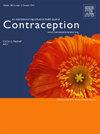社区避孕机构规模测算。
IF 2.3
2区 医学
Q1 OBSTETRICS & GYNECOLOGY
引用次数: 0
摘要
目的:评估避孕机构量表(CAS),作为一种基于临床的措施,在社区人口中发展,并评估机构如何随人口和生殖特征而变化。研究设计:我们在2023年对居住在俄勒冈州的1,917名年龄在15-45岁的参与者进行了横断面调查。参与者回答了7个项目的CAS,包括在他们最后一次医疗保健访问期间涉及避孕咨询的主动决策、免于胁迫和非判断性护理。我们评估了CAS的维度,并将数据拟合到部分信用模型中,以分析其在社区样本中的心理测量性能。通过多变量线性回归评估不同特征的代理差异。结果:CAS具有良好的内部一致性信度(Cronbach alpha: 0.78)。CAS项目大多加载到单个因素上,并证明了对部分信用模型的合理拟合(INFIT统计数据范围从0.73到1.01)。虽然黑人受试者的CAS评分低于白人受试者(β系数:-1.39(-2.19,-0.59)),但结论:CAS可以在社区样本中用于评估以患者为中心的避孕决策作为护理标准。本文章由计算机程序翻译,如有差异,请以英文原文为准。
Measuring contraceptive agency in the community
Objectives
This study aimed to evaluate the Contraceptive Agency Scale (CAS), developed as a clinic-based measure, within a community population and to assess how agency varied by demographic and reproductive characteristics.
Study design
We conducted a cross-sectional survey of 1917 participants aged 15–45 years living in Oregon in 2023. Participants responded to the 7-item CAS, comprised items relating to active decision-making, freedom from coercion, and nonjudgmental care during their last health care visit involving contraceptive counseling. We assessed the dimensionality of the CAS and fit data to a partial credit model to analyze its psychometric performance in our community-based sample. Differences in agency by characteristics were assessed with multivariable linear regression.
Results
The CAS showed adequate to good internal consistency reliability (Cronbach alpha: 0.78). The CAS items mostly loaded onto a single factor and demonstrated reasonable fit to a partial credit model (information-weighted fit statistics ranged from 0.73 to 1.01). While participants identifying as Black had lower CAS scores than White participants (β coefficient: −1.39 [−2.19, −0.59], p < 0.001), Asian/Pacific Islander, Latino/a, and multiracial participants had significantly higher levels of contraceptive agency than White participants. Not desiring pregnancy was associated with higher contraceptive agency (β coefficient: 1.27 [0.72, 1.82], p < 0.001) In contrast, lower education, some college or less vs college or above (β coefficient: −2.14 [−2.69, −1.60], p < 0.001) and nonbinary/transgender identity vs female gender identity (β coefficient: −1.32 [−2.15, −0.50], p < 0.01) were associated with lower contraceptive agency.
Conclusions
The CAS can be used in a community sample to evaluate patient centered contraceptive decision making as a standard of care.
Implications
Analysis of contraceptive agency among a community-based participant population offers valuable insights into experiences with contraceptive counseling.
求助全文
通过发布文献求助,成功后即可免费获取论文全文。
去求助
来源期刊

Contraception
医学-妇产科学
CiteScore
4.70
自引率
17.20%
发文量
211
审稿时长
69 days
期刊介绍:
Contraception has an open access mirror journal Contraception: X, sharing the same aims and scope, editorial team, submission system and rigorous peer review.
The journal Contraception wishes to advance reproductive health through the rapid publication of the best and most interesting new scholarship regarding contraception and related fields such as abortion. The journal welcomes manuscripts from investigators working in the laboratory, clinical and social sciences, as well as public health and health professions education.
 求助内容:
求助内容: 应助结果提醒方式:
应助结果提醒方式:


